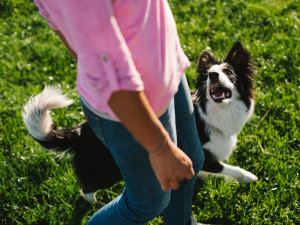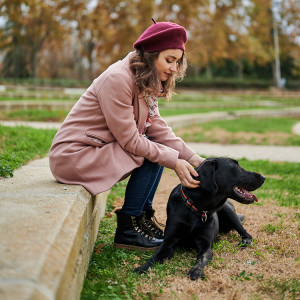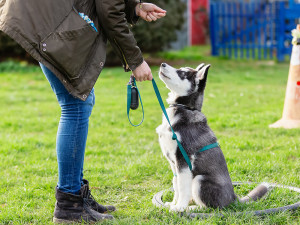Can You Teach a Dog to Talk? Five Training Techniques
Look who’s talking!
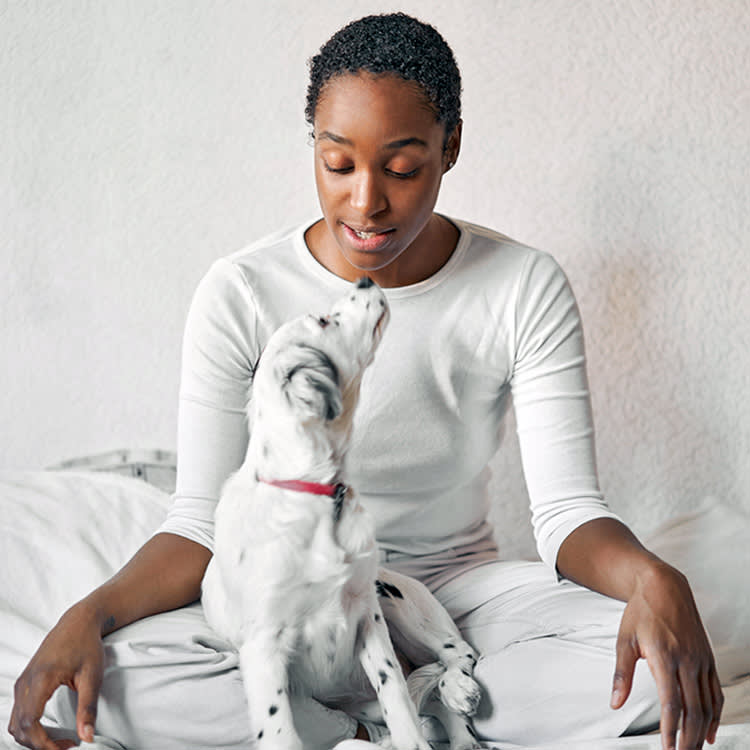
Share Article
In This Article:
Can Dogs Talk? How to Train a Dog to Talk Verbal Training Hand Signals Nose Targeting Bell Training Button Training How To Find Button Device Trainer
When I first brought home my Miniature Poodle puppy, he kept having accidents on the floor right next to the door. He was so close to making it outside, but if I didn’t see him standing at the door, he wasn’t able to hold it. If only dogs could talk, I thought. Then I had an idea.
I tied a bell to the door handle and taught my puppy to ring it with his nose when he wanted to go out to potty. It was a huge breakthrough in his potty training, and I celebrated. My dog was communicating with me!
But could there be more to this human and canine communication? Could you teach a dog to talk? I talked to U.K.-based dog behaviorist and trainer Annie-mae Levyopens in new tab, who says it just depends on how you define talking.
Can dogs talk?
“Dogs certainly do use body language and vocalizations to communicate with us,” Levy says. “For example, dogs might bark at us when frustrated or lick their lips a lot when feeling unsure.”
As it turns out, dogs c an understand human words, which means you can talk to your dog. And your dog has the potential to talk back through targeting (touching an object with their nose or paw). They can do the same thing with button devices that allow your dog to “talk” to you about objects or activities.
Do dogs understand words?
Yes, dogs do understand words. Most dogs organically learn their own names as well as common terms like “walk,” “no,” and “treat” through simple association. Dogs can also be taught words, such as when you train your dog to sit, lie down, and come.
How many words can a dog understand?
Studies have shown that on average dogs can learn about 165 wordsopens in new tab. So-called “super dogs” in the top 20th percentile of intelligence can learn 250 words. A famous Border Collie named Chaser learned 1,022 wordsopens in new tab — on par with the vocabulary of a human three-year-old child.
Is barking a dog’s way of talking?
According to Levy, barking is similar to talking, but it’s far less complex than human language. “Dogs bark in many different pitches and patterns to signal lots of things,” she says. “Dogs do not communicate with us or one another like humans do, though. They bark to signal how they feel about something in their immediate environment usually.”
How to train a dog to talk
We can teach dogs a series of behaviors that build on each other allowing for greater communication between dog and human. Your communication will continue to grow whether your dog is responding to simple cues or hand signals, ringing a bell to go outside, or communicating through button devices that allow your dog to “speak,” using your voice recordings.
Verbal training
Training a dog to respond to verbal communication is a process of association. Positive-reinforcement training techniques make it simple to connect a word with a behavior (or an object). Use small treat rewards or praise when your dog gets it right. When teaching verbal cues, choose one specific word for the behavior and always use it. For instance, don’t say “down” sometimes and “lie down” other times — choose one or the other.
To teach a verbal cue, follow these steps:
Get your dog’s attention.
Using a treat, lure the dog to perform the behavior.
Reward their success.
Lure the dog to perform the behavior, and say the cue.
Reward their success.
Eventually fade the lure and just say the cue.
Reward their success.
Repeat until they are consistent.
So, how many cues can a dog learn? The possibilities are endless for many dogs. As long as you and your dog are enjoying the training process, you can teach your dog almost anything.
Hand signals
Can dogs learn sign language? Yes! In fact, many dogs learn cues using both words and hand signals, and some respond faster to hand signals rather than verbal phrases. When teaching with hand signals, be sure to consistently use the same one every time.
The steps below explain how to teach a dog hand signals:
Get your dog’s attention.
Using a treat, lure the dog to perform the behavior.
Reward their success.
Display the hand signal, then lure the dog to perform the behavior.
Reward their success.
Eventually fade the lure and just display the hand signal.
Reward their success.
Pair the verbal cue with the hand signal.
Reward their success.
Repeat until they are consistent.
Nose-targeting
Nose-targeting is a skill that can bring your dog’s communication to the next level. Simply put, you’re teaching your dog to touch an object with its nose. You can also teach dogs to target with their paws, but teach nose- targeting first; it’s easy to capture this behavior. Have you ever wondered, Why do dogs touch you with their nose? There’s a good reason: Dogs are highly scent-driven, so they are naturally inclined to investigate things with their nose first.
To teach nose-targeting, follow these steps:
Hold your palm flat out toward your dog.
Reward any interest in your hand, such as sniffing.
Repeat until your dog is quickly investigating your hand.
Begin rewarding only for strong touches rather than sniffs.
Increase the distance so your dog must come toward your hand to touch it.
Reward their success.
Add a verbal command, such as “touch.”
Repeat until they are consistent.
Once your dog understands the concept of nose targeting with your hand, you can transfer the skill to another object by presenting it close to your dog and saying “touch.” Gradually move the object further from your dog so they must approach it to touch. Now you’re ready to teach your dog to ring a bell, like I did with my miniature poodle.
Bell training
Teaching a dog that understands nose targeting to ring a bell is simple. This is a great skill that allows your dog to ask you to be let outside to potty. Here’s how to bell train a dog:
Hang a bell from a door handle or somewhere close to your door.
Make sure the bell is at your dog’s nose level.
Ask your dog to nose-target the bell by saying, “Touch.”
Reward success by opening the door and giving a treat.
Begin rewarding only for strong touches rather than sniffs.
Always open the door, and give them a treat.
Reward independent use of the bell with extra praise and treats.
Button training
Once your dog knows the “touch” cue, you can move on to teaching them to touch button devices. These devices are relatively new to the dog training scene. The buttons allow you to record your voice saying a word, such as “walk,” “treat,” or “outside.” Training your dog to touch the buttons to communicate is not only fun, but can increase your bond and understanding of each other.
When these button devices first became popular, many people were skeptical that dogs were really understanding language and using the devices to “talk.” A recent studyopens in new tab says that dogs are not simply imitating their owners when they touch the buttons, but are in fact using the devices deliberately with intent, including using two-word combinations to form simple “sentences.”
Training a dog to talk with button devices can be a long process, especially progressing from naming objects to naming activities like “go outside.” But Levy says it’s a process of association, similar to teaching dogs other skills.
“Press the button yourself every time you do the action,” she adds. “As you’re walking through the front door you can press an ‘outside’ button. Once you have done a few reps of this, ask your dog to touch the button themselves and then complete the action. You will need to repeat this about 50 times for your dog to start to understand the association.”
Here’s how to train dogs to use buttons in simple steps:
Record the word you want to teach on the button (for example, “Ball”).
Press the button for the ball and present the ball.
Repeat this many times.
Ask your dog to nose-target the button by saying, “Touch.”
Present the ball when the dog presses the button.
Repeat this many times.
Repeat and build your training vocabulary to include objects, actions, and behaviors.
“There are tons of videos you can use on the internet if you get stuck, but the premise is pretty simple—have your dog touch the button, and then follow up with the associated behavior or action,” Levy says.
How to find a button-communication device
Dog-button devices are available online and in some pet-supply stores. Most devices are recordable so you can customize the words you want to teach your dog. Teaching this skill can take a long time, but it can be a rewarding activity. If you’re having trouble, reach out to a reputable dog trainer who is comfortable working with the buttons.
References
Amalia, et al. “How Do Soundboard-Trained Dogs Respond to Human Button Presses? An Investigation into Word Comprehension.” PLoS ONE, vol. 19, no. 8, 28 Aug. 2024, pp. e0307189–e0307189, https://doi.org/10.1371/journal.pone.0307189opens in new tab.
Bradshaw, John, and Nicola Rooney. “Dog social behavior and communication,” The Domestic Dog. Cambridge: Cambridge University Press, 2017. https://books.google.com/books?hl=en&lr=&id=4fB7DQAAQBAJ&oi=fnd&pg=PA133&dq=dog+communication+signals&ots=YQqCW1mVt8&sig=ykKy6ZUwkX2BcD_-yRGLPbt_kRY#v=onepage&q=dog%20communication%20signals&f=falseopens in new tab.
Chiandetti, Cinzia, et al. “Can Clicker Training Facilitate Conditioning in Dogs?” Applied Animal Behaviour Science, vol. 184, no. 1, Nov. 2016, pp. 109–116, www.sciencedirect.com/science/article/pii/S0168159116302386opens in new tab, https://doi.org/10.1016/j.applanim.2016.08.006opens in new tab.
Faragó, Tamás, et al. “The Information Content of Wolf (and Dog) Social Communication.” Biocommunication of Animals, 21 Aug. 2013, pp. 41–62, https://doi.org/10.1007/978-94-007-7414-8_4opens in new tab.
Kokocińska-Kusiak, Agata, et al. “Canine Olfaction: Physiology, Behavior, and Possibilities for Practical Applications.” Animals, vol. 11, no. 8, 1 Aug. 2021, p. 2463, www.ncbi.nlm.nih.gov/pmc/articles/PMC8388720/opens in new tab, https://doi.org/10.3390/ani1108246opens in new tab3opens in new tab.
Lesch, Raffaela, et al. “Talking to Dogs: Companion Animal-Directed Speech in a Stress Test.” Animals, vol. 9, no. 7, 4 July 2019, p. 417, https://doi.org/10.3390/ani9070417opens in new tab.
Lind, Miriam. “When Dogs Talk: Technologically Mediated Human-Dog Interactions as Semiotic Assemblages.” Signs and Society, vol. 12, no. 1, 1 Jan. 2024, pp. 14–36, https://doi.org/10.1086/728033opens in new tab. Accessed 24 Apr. 2024.
Mariti, Chiara, et al. “Analysis of the Intraspecific Visual Communication in the Domestic Dog (Canis Familiaris): A Pilot Study on the Case of Calming Signals.” Journal of Veterinary Behavior, vol. 18, Mar. 2017, pp. 49–55, https://doi.org/10.1016/j.jveb.2016.12.009opens in new tab.
Robinson, Charlotte, and Alice Torjussen. “Canine Co-Design.” Proceedings of the 2020 ACM Designing Interactive Systems Conference, 3 July 2020, https://doi.org/10.1145/3357236.3395462opens in new tab.
Siniscalchi, Marcello, et al. “Communication in Dogs.” Animals, vol. 8, no. 8, 31 July 2018, p. 131. MDPI, www.ncbi.nlm.nih.gov/pmc/articles/PMC6116041/opens in new tab, https://doi.org/10.3390/ani8080131opens in new tab.
Williams, Marc, and James M Johnston. “Training and Maintaining the Performance of Dogs (Canis Familiaris) on an Increasing Number of Odor Discriminations in a Controlled Setting.” Applied Animal Behaviour Science, vol. 78, no. 1, Aug. 2002, pp. 55–65, https://doi.org/10.1016/s0168-1591(02)00081-3.opens in new tab
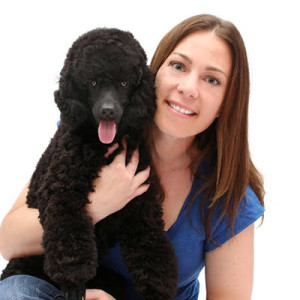
Jackie Brown
Jackie Brown lives in sunny Orange County, CA, where she works as a freelance writer and editor. When she’s not on deadline, you can find her paddling her outrigger canoe in the Pacific Ocean or hiking in the foothills with her miniature poodle and two young boys.
Related articles
![Woman sitting with her dog outdoors]()
How to Talk to Your Dog, According to Science
Baby talk works on puppies. As for adult dogs, that’s still up for debate.
![]()
What Are Dog Communication Buttons? And How to Use Them
Cognitive Science professor Dr. Federico Rossano on how Bunny, TikTok’s “talking” dog, is sparking change in how we communicate with our pets.
Can Dogs Communicate With Each Other?
It’s about more than barking.
![Woman wearing a magenta beret hat and a pink coat sitting on a wall outside and petting her black Labrador dog laying on the ground]()
How to Interpret Your Dog’s Facial Expressions and Behavior
Managing expectations about your dog’s behavior makes for a good relationship
![Woman trains with a young husky on a dog training field]()
How to Find a Qualified Trainer for Your New Dog
The questions to ask and credentials to look out for to find the right trainer for your dog, according to a pro.
![Greyhound puppy sitting on her bed on the bedroom floor]()
Use Platform Dog Training to Elevate Your Pup’s Skills
Using platforms are favorites with pro dog trainers—here’s why you should add them to your training to-do list.

